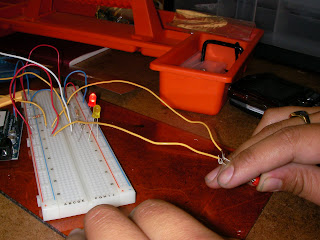Then an idea came to me: What if Hobos (Hoboes? Hobi?) could keep themselves warm?
For my first stupid pet trick I was going to create a Hobo Warmer.
I sewed a thermoster, a sensor that senses heat, into a pair of gloves.

I then hooked up the gloves to five LEDs that will light up one at time the more heat you generate while rubbing your hands together.

Before I used the gloves, I tried it with one LED to make sure it worked.
Pet Trick Test! from Krystal Banzon on Vimeo.
Hobo Warmth - My First Pet Trick from Krystal Banzon on Vimeo.
CODE:
int potPin = 0; // Analog input pin that the potentiometer is attached to
int sensorValue = 0; // value read from the analog sensor
int led0 = 3; // PWM pin that the LED is on. n.b. PWM 0 is on digital pin 9
int led1 = 4;
int led2 = 7;
int led3 = 8;
int led4 = 12;
void setup() {
// initialize serial communications at 9600 bps:
Serial.begin(9600);
// declare the led pin as an output:
pinMode(led0, OUTPUT);
pinMode(led1, OUTPUT);
pinMode(led2, OUTPUT);
pinMode(led3, OUTPUT);
pinMode(led4, OUTPUT);
}
void loop() {
sensorValue = analogRead(potPin); // read the pot value
// map the sensor vaue from the input range (400 - 900, for example)
// to the output range (0-255). Change the values 400 and 900 below
// to match the range your analog input gives:
int brightness = map(sensorValue, 26, 27, 0, 255);
analogWrite(led0, brightness); // set the LED brightness with the result
int brightnessMore = map(sensorValue, 29, 30, 0, 255);
analogWrite(led1, brightnessMore);
int brightnessEvenMore = map(sensorValue, 31, 32, 0, 255);
analogWrite(led2, brightnessEvenMore);
int brightnessMost = map(sensorValue, 33, 34, 0, 255);
analogWrite(led3, brightnessMost);
int brightnessBest = map(sensorValue, 35, 37, 0, 255);
analogWrite(led4, brightnessBest);
Serial.println(sensorValue); // print the pot value back to the debugger pane
delay(20); // wait 10 milliseconds before the next loop
}
PAST LABS:
Electronics Lab

All right! Testing voltage with a micrometer.

Video of my breakthrough figuring out the servomotor using a flex sensor!
Working hard with my girl, Lisa Maria.

Shoutout to my boys Benji and Garrad!

For more pictures of the all night work party, click here!













